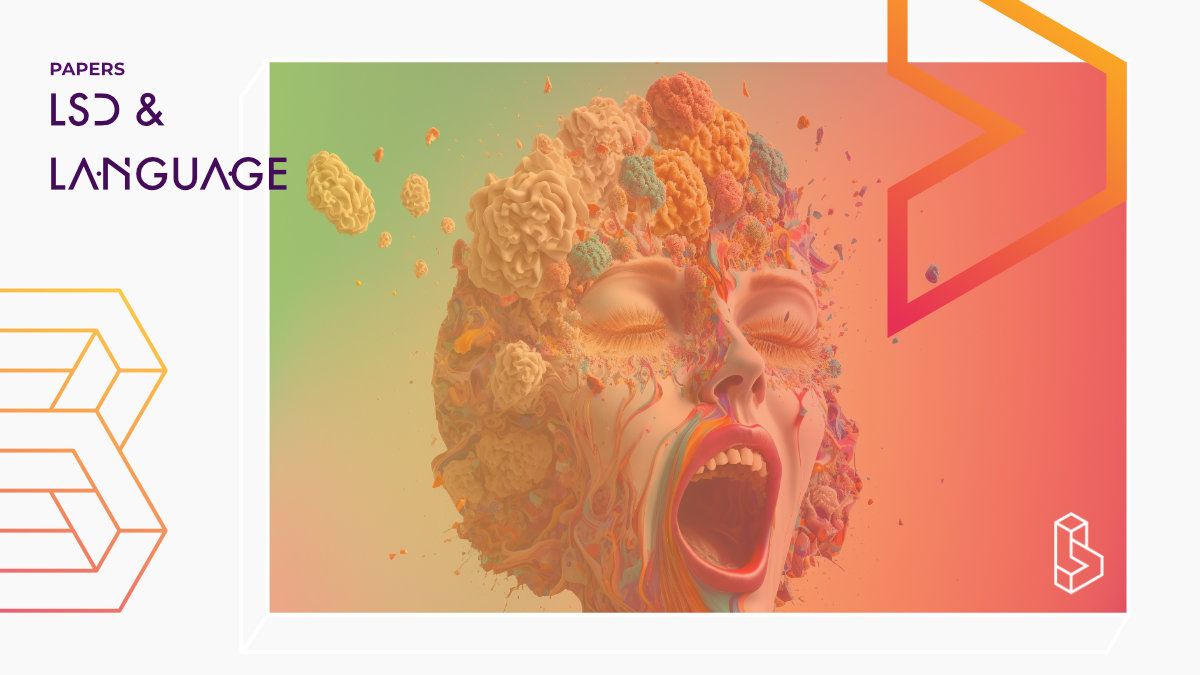This double-blind cross-over study (n=24) of a low/moderate dose of LSD (50μg) on the structure of language finds simpler and semantically more similar language after LSD.
Abstract
“Language has been explored as a window into the mind. Psychedelics, known to affect perception and cognition, seem to change language, but a systematic, time-dependent exploration is lacking. Therefore, we aimed at mapping the psychedelic effects on language over the time course of the acute and sub-acute effects in an explorative manner. For this, 24 healthy volunteers (age [mean±SD, range]: 35±11, 25–61 years; 33% women) received 50 μg lysergic acid diethylamide (LSD) or inactive placebo in a randomized, double-blind, placebo-controlled, crossover study. We assessed different language productions (experience reporting, storytelling), components (structure, semantics, vocabulary) and time points (+0 h to +24 h). Language productions included 5-min experience reporting (+1.5 h, +6.5 h) and 1-min storytelling (+0 h, +2 h, +4 h, +6 h, +24 h). Language structure was assessed by computing speech topology (SpeechGraphs), semantics by semantic distances (FastText), vocabulary by word categories (LIWC). LSD, compared to placebo, changed language structure, including decreased verbosity, lexicon, global and local connectivity (+1.5 h to +4 h); decreased semantic distances between neighbouring words and overall words (+2 h to +24 h); and changed vocabulary related to grammar, persons, time, space and biological processes (+1.5 h to +24 h). In conclusion, low to moderate LSD doses changed language over diverse production types, components and time points. While simpler and disconnected structure and semantic similarity might reflect cognitive impairments, changed vocabulary might reflect subjective perceptions. Therefore, language under LSD might provide a window into the psychedelic mind and automated language quantifications should be better explored as valuable tools to yield more unconstrained insights into psychedelic perception and cognition.”
Authors: Isabel Wießner, Marcelo Falchia, Dimitri Daldegan-Bueno, Fernanda Palhano-Fontes, Rodolfo Olivieri, Amanda Feilding, Draulio B. Araujo, Sidarta Ribeiro, Natália B. Mota & Luís F. Tófoli
Summary of LSD and Language
Language is a fundamental tool for human communication, enabling us to express thoughts and experiences and tell stories. Recent computational approaches provide powerful tools for automated language quantifications, such as structural analyses of speech connectedness and semantic analyses of dream content.
Serotonergic psychedelics alter perception, emotion and cognition, but are often measured by predefined items in self-report questionnaires. So, might psychedelic language provide a more direct window into the psychedelic mind?
Psychedelics increase semantic distances in free association and creativity tasks, and semantic similarities to positive sentiment. Online experience reports describe thinking distortions, emergencies and perceptual alterations.
Find this paper
https://doi.org/10.1016/j.euroneuro.2022.12.013
Paywall | Google Scholar | Backup | 🕊
Study details
Compounds studied
LSD
Topics studied
Healthy Subjects
Creativity
Study characteristics
Placebo-Controlled
Double-Blind
Within-Subject
Randomized
Re-analysis
Participants
24
Humans
Authors
Authors associated with this publication with profiles on Blossom
Amanda FeildingAmanda is the Founder and Director of the Beckley Foundation. She's called the 'hidden hand' behind the renaissance of psychedelic science, and her contribution to global drug policy reform has also been pivotal and widely acknowledged.
Luís Tófoli
Luís Tófoli is a professor at UNICAMP and one of the organizers of ICARO, his work is mostly done in Brazil and focused on ayahuasca.
Institutes
Institutes associated with this publication
University Federal of Rio Grande do NorteUniversity Federal of Rio Grande do Norte research with psychedelics has been taking place for the past ten years and more.
Compound Details
The psychedelics given at which dose and how many times
LSD 50 μg | 1xLinked Research Papers
Notable research papers that build on or are influenced by this paper
LSD and creativity: Increased novelty and symbolic thinking, decreased utility and convergent thinkingThis double-blind placebo-controlled study (n=24) assessed the impact LSD (50μg) has on measures of creativity. Near peak drug effects, participants were given a number of creative tasks to complete. Creativity was then assessed by scoring creativity criteria, calculating divergent thinking and convergent thinking, computing semantic distances and searching for data-driven special features. Compared to placebo, LSD changed several creativity measurements pointing to pattern break, disorganization and meaning which seemed to fundamentally influence creative cognition and behaviour.

